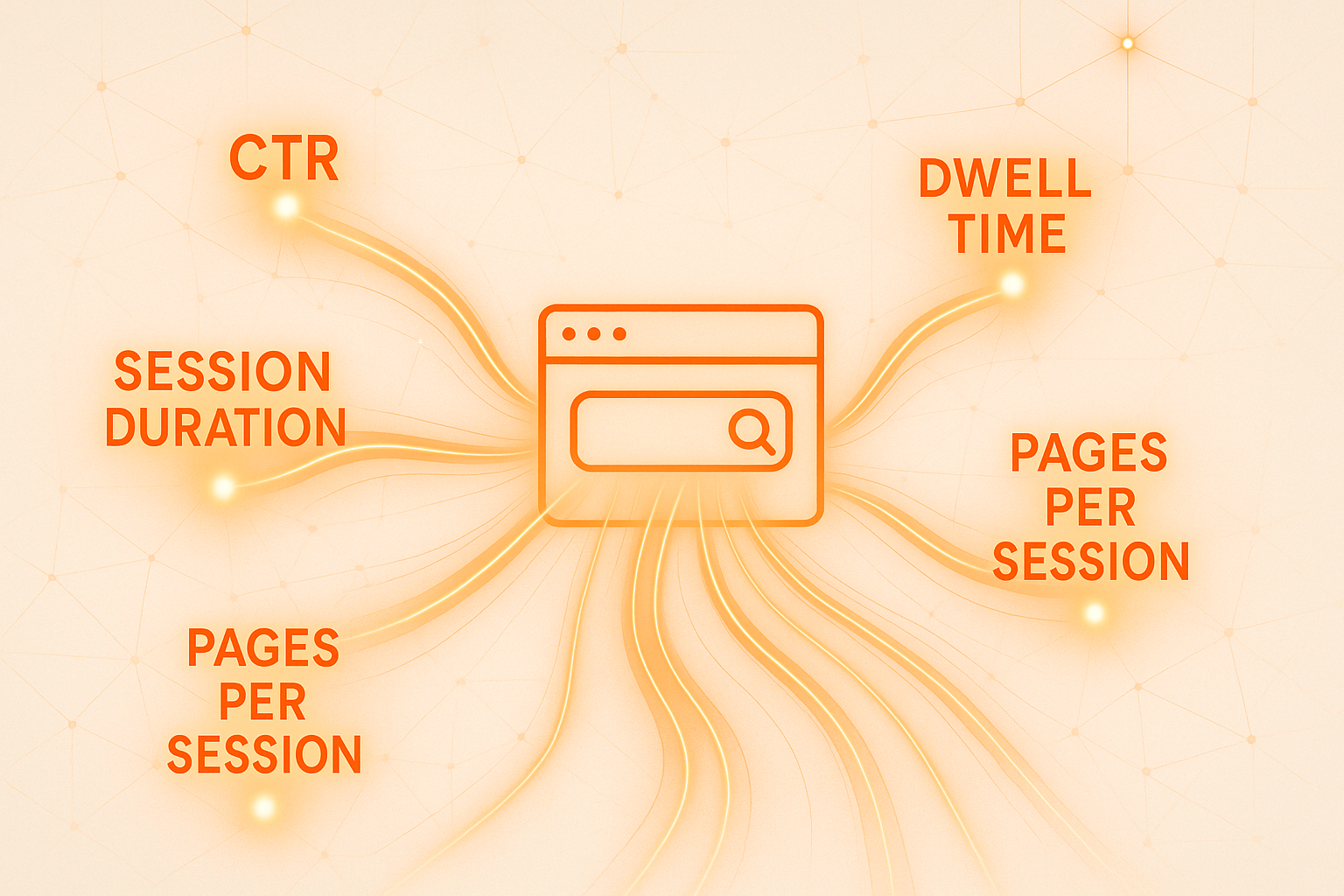Website engagement: Why it matters for SEO, conversion and growth
Why website engagement matters now more than ever
Website engagement is crucial in today’s ever-crowded SEO market. Website engagement is especially important for B2B enterprises aiming to enhance their online presence and stand out. As businesses compete for attention in an increasingly crowded market, understanding how engagement metrics can influence search rankings and user experience is vital. It is almost as important as SEO automation. Here’s what matters and why:
- Click-through rate (CTR) helps measure how effectively your content draws users in.
- Dwell time indicates the quality of your content, showing whether visitors find your information valuable.
- Session duration reflects user interest and satisfaction with your site, influencing search rankings.
- Pages per session reveal how well you retain visitors and guide them through your content.
- Engagement rate in GA4 provides insights into overall site interaction, critical for evaluating digital strategy effectiveness.
- These metrics serve as essential signals for Google’s Helpful Content and UX-focused ranking algorithms, impacting how your site ranks in search results.

Core website engagement metrics and their significance
Understanding the core engagement metrics is essential for deciphering the effectiveness of your website engagement. Start with the bounce rate compared to the engagement rate; while a high bounce rate might sound alarming, it can sometimes indicate a well-targeted audience that simply found what they needed quickly.
Scroll depth measures how far down the page users go, shedding light on content engagement levels and areas that may need enhancement. Moreover, tracking events like video plays or downloads gives you insights into users interacting with your content on a deeper level, hinting at what captures their interest. Micro-conversions—those small actions that lead to larger goals—also play a vital role; they reflect user engagement before they complete a major conversion action.
Next, let’s consider session duration and pages per session. A longer session duration typically indicates that users find your content compelling enough to linger, while multiple pages per session suggest that your content is effectively guiding visitors on a journey through your site.
And, of course, the click-through rate (CTR) ties everything together by measuring how successful your titles and meta descriptions are in attracting clicks from search results, ultimately showcasing the on-site value your content offers. When these metrics are understood and optimised, they can significantly elevate your website’s performance and drive meaningful interactions.
The importance of trust in B2B enterprises
In the realm of B2B enterprises (where Fifty Five and Five live), where high-ticket items and extended sales cycles dominate the landscape, establishing trust is paramount. Website engagement metrics serve as powerful indicators of reliability, demonstrating to potential clients that your offerings are credible and worth investing in. When businesses actively engage their website visitors, they create an environment where users feel valued and understood.
When your content resonates with your audience, it signals to search engines that your site holds authoritative information. Strong website engagement signals – such as longer session durations, lower bounce rates, and multiple page views – effectively reinforce keyword rankings and enhance domain trust. These factors play a vital role in how search engines evaluate and rank your site, making them crucial for B2B companies looking to solidify their online presence.
Moreover, users who spend time interacting with quality content are more likely to develop a sense of trust in the brand behind that content. For B2B enterprises with longer buying cycles, building this trust is essential as potential clients often conduct extensive research before making significant purchasing decisions. The confidence gained through meaningful interactions can ultimately sway clients during their decision-making process.
Furthermore, rich snippets derived from engaging content increase visibility in search engine results pages. Although the idea of zero-click SEO – where users receive their answers directly in the search results without visiting your site – may seem counterintuitive, good website engagement allows businesses to optimise their web presence effectively. High engagement often translates to better representation in rich snippets, driving increased visibility and recognition. This can lead to potential clients associating high-quality content with trustworthiness and reliability.
In sector-focused B2B markets, where buyers are often cautious and discerning, trust can differentiate your organisation from competitors. With robust website engagement metrics, you not only prove the quality of your content but also demonstrate a commitment to serving your audience’s needs. B2B companies must view engagement as an ongoing strategy, continually assessing their performance and optimising to reinforce trust.
Ultimately, when B2B enterprises focus on engagement, they inadvertently cultivate a trusting brand image. The interplay between content, engagement, and trust not only elevates SEO performance but also enhances the overall user experience, fostering deeper connections with potential clients. In a landscape driven by long sales cycles and high-value transactions, nurturing this trust is the bedrock of successful B2B marketing.
Website engagement helps feed your SEO automation pillar
A strong focus on engagement can significantly enhance your SEO automation efforts. Better website engagement leads to increased internal linking, the creation of content clusters, and the establishment of effective signal loops within your SEO automations. This interconnectedness not only strengthens your website’s authority in the eyes of search engines but also enhances user experience and retention. As you improve website engagement metrics, consider how they integrate with your broader SEO strategy to create a cohesive approach that drives both traffic and conversions.

Zero-click and AI-generated summaries
AI-generated summaries, such as search overviews, featured snippets, and knowledge panels, provide instant answers directly on search engine results pages (SERPs) without requiring users to click through. This functionality has transformed how users interact with search engines, enabling them to receive concise information promptly. Understanding these innovations is essential for adapting your SEO strategy to the current landscape. Basically everyone’s traffic is going down, and you need to know why and what to do about it!
Approximately 60% of all searches now end without a click
The significance of zero-click searches really cannot be underestimated. Approximately 60% of all searches now end without a click, which implies that a large volume of searchers are satisfied with the immediate responses offered directly on SERPs. This shift indicates a critical change in user behaviour and highlights the need for B2B enterprises to rethink their content strategies.
As users receive comprehensive answers in summary formats, the necessity for your pages to deliver additional value becomes apparent. Instead of duplicating the information presented in AI snippets, your content should offer enriching elements such as interactive tools, engaging widgets, and deeper insights that cannot be captured in a simple summary. We think this will be big in the future, but is for now an experimental area only.
But investing in original, interactive content is a strategic imperative for improving website engagement, and it might just help in the world of zero-click, so win win! Creating content that surpasses what AI can provide encourages users to click through to your site, allowing you to build a meaningful interaction. By positioning your content as a valuable resource, you enhance your chances of attracting visitors who are seeking more than just a summary.
Tactics to boost website engagement
To enhance website engagement on your website and ensure visitors have a fulfilling experience, consider implementing the following ten strategies:
1. Optimise load speed: Focus on improving core web vitals such as Largest Contentful Paint (LCP) and Interaction to Next Paint (INP) to ensure your site loads quickly, especially on mobile devices.
2. Ensure mobile-friendly design: As more users access websites via mobile, it’s crucial to implement responsive design practices that cater to mobile browsing effectively.
3. Enhance readability: Use clear fonts, appropriate font sizes, and ample white space to improve the readability of your content, making it easily digestible for all visitors.
4. Incorporate multimedia elements: Add images, videos, and infographics to break up text and provide visual interest; these elements can help keep users engaged and improve comprehension.
5. Create interactive content: Develop interactive tools like quizzes, polls, or calculators that not only engage users but also encourage them to participate actively.
6. Add internal links: Use internal linking to guide visitors to related content on your site, which can increase session duration and improve navigation, keeping users on your site longer.
7. Suggest related content: Implement suggestions for additional articles or resources at the end of a blog post to encourage further exploration of your site.
8. Utilise call-to-action buttons: Strategically place compelling calls to action within your content to guide users towards the next steps, whether it be signing up for newsletters, downloading resources, or contacting your team.
9. Monitor engagement metrics: Use analytics tools to track user interactions and engagement metrics regularly, allowing for data-driven decisions regarding content adjustments and strategy optimisations.
10. Foster a community feel: Encourage comments or discussions on your content and actively engage with your audience. This creates a sense of community and encourages users to return.

Website engagement tools and tracking
Of course there is a world of website engagement tools out there to help you:
| Tool | Pros | Cons |
|---|---|---|
| Google Analytics 4 | Comprehensive metrics, user-friendly interface | Steep learning curve for advanced features |
| Hotjar | Excellent heatmaps, user session playback | Limited features on free tier |
| Crazy Egg | Easy A/B testing, clear visual reports | Can be costly for larger sites |
| Optimizely | Robust A/B testing, good customer support | Price may be high for smaller businesses |
| Mixpanel | Strong event tracking and segmentation | Requires integration setup |
| VWO | Multi-channel testing, powerful insights | Interface can be overwhelming |
| Mouseflow | Session recording, funnel analysis | Limited reporting features for the free version |
| Heap | Automatic event tracking, good customer insights | Learning curve with setup and features |
| Clicktale | Great for user-centric metrics | Some features may lag behind competitors |
| FullStory | In-depth session recording, error tracking | Pricing can be a factor for small organisations |
Frequently asked questions on common mistakes to avoid?
1. Over-optimising for one metric: What happens when you focus solely on improving a single engagement metric? It can lead to skewed insights. Instead, consider the holistic performance of your site and how various metrics interrelate to provide a clearer picture of user engagement.
2. Ignoring user intent: Why is it important to understand why visitors come to your site? Ignoring their intent can result in content that misses the mark, leading to higher bounce rates and dissatisfied users. Tailoring content to meet users’ needs enhances satisfaction and improves website engagement.
3. Mistaking bounce rate for a bad visit: Does a high bounce rate always indicate a problem? Not necessarily. A high bounce rate can suggest that users found the information they needed quickly and left satisfied. Misinterpreting this metric can compel unnecessary changes, distorting your overall engagement strategies. Recognising the context behind the bounce rate allows for more informed decision-making.
4. Neglecting content updates: Why should you regularly update your content? Outdated information can frustrate users, leading to decreased engagement. Keep your content fresh by making regular updates to maintain user interest.
5. Not optimising for mobile: Are you ignoring mobile users? With increasing mobile traffic, a non-responsive design can alienate a significant part of your audience. Ensure that your site is mobile-friendly to improve engagement across all devices.
6. Forgetting about page speed: How does page speed affect engagement? Slow-loading pages can frustrate users, leading to high bounce rates. Optimise your site’s load time to keep visitors engaged and happy.
7. Lacking clear calls to action: Why is it important to have clear calls to action (CTAs)? If users don’t know what to do next, they may leave your site. Use persuasive CTAs that guide visitors towards desired actions, like signing up for newsletters or exploring further content.
8. Ignoring analytics data: What can analytics tell you? If you overlook data about user behaviour and engagement metrics, you might miss valuable insights that could improve your strategy. Regularly review your analytics to inform your decisions.
9. Failing to personalise user experiences: How does personalisation affect engagement? Generic experiences can fail to resonate with users. Implement personalisation strategies to tailor content and offers based on user behaviour and preferences.
10. Overlooking user feedback: Why should you value user feedback? It provides insights directly from your audience about their experiences. Ignoring this feedback can keep you from improving your site and meeting users’ needs effectively.